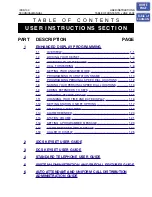
Shure Incorporated
12/16
No sound
Check the power supply of the microphone and receiver.
Ensure that the batteries are inserted correctly.
Set the transmitter and receiver to the same channel.
Check that the receiver is connected to the input on the audio mixer or amplifier.
Check that the transmitter is not too far away from the receiver.
Decrease (counterclockwise) the squelch.
Set the bodypack audio input switch to MIC.
Make sure that the receiver has a clear, line-of-sight path to the transmitter.
Keep the receiver away from metal objects.
Noise from RF
interference
Replace the transmitter batteries.
Check the receiver antenna location. Make sure there is a clear path between the receiver and the trans
mitter.
When using two or more systems simultaneously, chose different channels within the same group (chan
nels 1-4 or channels A-D). For the JB1 band, there are three groups: channels 1-3, 4-6, and 7-8.
Turn off or relocate possible sources of interference such as cell phones, radios, or other electronic de
vices.
Increase squelch (clockwise) to restrict the receiver from picking up ambient noise.
Unplug any unused receivers
Audio distor
tion
Adjust levels on the mixer board or sound system.
Make sure all cables are securely connected from the receiver to the sound system.
If using a bodypack transmitter, lower the gain settings.
Specifications
Working Range
HI power mode
75
m
(250
ft
) (Line of Sight)
LO power mode
18
m
(60
ft
) (Line of Sight)
Audio Frequency Response
50
–
15000
Hz
Total Harmonic Distortion
<0.5%
Dynamic Range
90
dB
, A-weighted, typical
Operating Temperature Range
-10° C (0° F) to 50° C (122° F)


































